17 Most Famous Johannes Vermeer Paintings in 2025
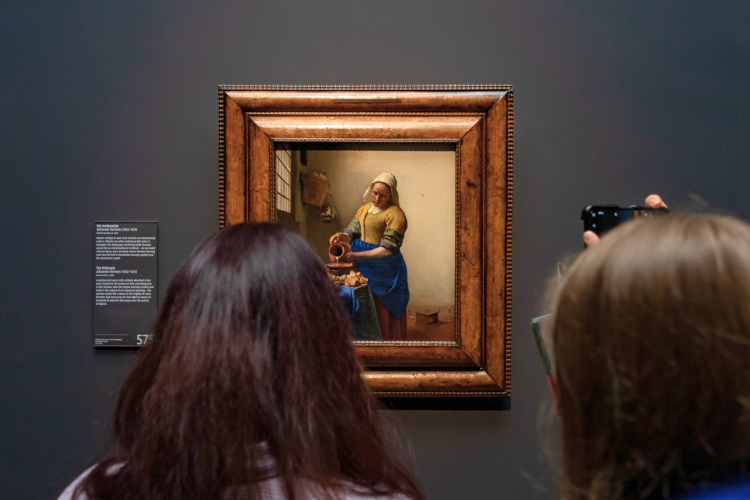
Johannes Vermeer paintings are famous for their use of light and perspective, but the painter himself is a somewhat mysterious figure in the realm of Dutch Golden Age art. This guide will give you a crash course on Vermeer’s history as well as share some of his most famous paintings with you.
What is the most valuable Vermeer painting? Where are the original Vermeer paintings? These are just a few of the questions that surround the Dutch painter Vermeer, also known as the Sphinx of Delft. According to the Encyclopedia Britannica, Vermeer paintings “are remarkable for their purity of light and form, qualities that convey a serene timeless sense of dignity.” This makes him one of the most famous painters in history.
Artists throughout history have tried to emulate Vermeer’s signature style and ability to capture light. So whether you're looking for acrylic painting ideas for beginners or trying to learn how to find your art style, exploring the life and works of Vermeer can be a great place to start.
Jump to Section
- Who Was Johannes Vermeer?
- Characteristics of Vermeer Paintings
- List of Vermeer Paintings in Exhibition
Who Was Johannes Vermeer?

Johannes Vermeer is highly regarded as one of the most famous painters of the Dutch Golden Age, a period that extended from the late 1500s to the mid-1600s. At this time, Dutch scientists and artists were making enormous strides in their respective fields.
Vermeer was born in 1632 in the city of Delft, a location that would be one of his main sources of inspiration and the setting for many of his greatest paintings. Little is known about Vermeer’s early life and training; in fact, not much about his personal life or Johannes Vermeer’s cause of death are certain.
Some believe that he was trained by the Dutch painter Fabritius, who is best known for his trompe l'oeil style paintings, which means "trick of the eye" and refers to highly realistic optical illusions used in paintings. Others argue that Vermeer was most impacted Rembrandt paintings or even by Caravaggio paintings. Regardless of whose art most impacted Vermeer, his style of painting gained acclaim on its own for his ability to capture light in his artwork.
Vermeer’s painting career started in earnest in 1654, when he began painting religious and symbolic works, like many artists of his day. Over time, his style evolved and the themes of his work began to be more introspective and focus more on daily life in Delft. He did see some small success as an artist during his lifetime, but his true fame came about much later in the 19th century, when his works were rediscovered. During his lifetime, his main income came from his profession as an art dealer. His paintings took a long time to create, and therefore he was not as prolific as other artists.
The famous painter died in December of 1675, but Johannes Vermeer’s cause of death is still somewhat unknown. We know that he struggled with a short illness before dying, but not much more.
Characteristics of Vermeer Paintings

You might hear Vermeer being called “The Sphinx of Delft.” Because we know so little about Vermeer’s personal life, this nickname points to his mysterious background as well as the place where he lived, died and set most of his paintings: Delft.
Vermeer’s paintings, especially those he created later in his career, show his own unique style. Vermeer is most famous for using a unique array of painting techniques to capture light. Most notable in his paintings is the way light is captured by pearls, silks and other materials. His most famous painting, "Girl With a Pearl Earring," is a perfect example of this.
Even the way Vermeer painted light, however, is a bit mysterious. The perspectives and shapes in his paintings are so perfect and exact that many wonder whether or not he used a device called a camera obscura to project an image and capture it perfectly before painting it. Whether or not he used this is up for debate, and many say that his painstaking, lengthy process shows that he didn’t need tricks like this to create a masterpiece.
Aside from his ability to capture light, Johannes Vermeer is famous for the calm, almost intimate themes of his portraits. Many of them are set in the same rooms and feature the same people, who often appear to be deep in thought. Almost all of his most famous paintings preserve that light, airy, but introspective quality we have come to associate with the Sphinx of Delft.
How Many Vermeer Paintings Are There?

How many Vermeer paintings exist today? We only know of 36 paintings that we can classify certainly as being made by Vermeer. This low number is probably due to his slow painting process. Many of his paintings took a long time to complete, which has been shown by careful analysis of his paint mediums and techniques.
Because there are so few Vermeer paintings, and because Vermeer has become so highly regarded since the 19th century, his paintings are incredibly valuable. How much is an original Vermeer painting worth? Most of the Vermeer paintings that have been sold at auction in recent years have sold for tens or hundreds of millions of dollars.
Are There Any Lost Vermeer Paintings?

Are there any paintings by Vermeer that have been lost to time? The answer is most likely yes. According to best estimates, there were around 60 Vermeer paintings over the course of his life. This is a low number, but it is almost double the number of paintings we still have in existence that he painted. For this reason, it’s easy to believe that many have been lost.
One of the most famous Vermeer paintings was also lost in an infamous art heist. "The Concert," a highly valuable painting by Vermeer that is estimated to be worth around $250 million, vanished during the 1990 Isabella Stewart Gardner art theft in Boston. This painting, along with Rembrandt’s only known seascape, are considered the most devastating losses of the heist, which remains unsolved to this day.
Another interesting and mysterious component to Vermeer paintings is that he often painted over elements as he changed his mind about the composition of his paintings. In fact, in one of the most valuable Vermeer paintings, there is an area that many believe includes Vermeer’s picture of himself, but the painter painted over it in a later version. The hidden self-portrait is a mystery, just like so much of his life and lost work.
List of Vermeer Paintings in Exhibition
1. Girl With a Pearl Earring (1664–67)

Perhaps one of the most well-known Vermeer paintings, "Girl With a Pearl Earring" is a technical masterpiece that has been turned into memes, movies and pop culture references for centuries. While there is not as much symbolism present in this painting as in some of Vermeer’s other works, his ability to capture the light on the model's eyes and her earring, not to mention the shiny silk fabric of her headdress, shows him at his best. Try your hand at making your own version of this Vermeer masterpiece next time you're looking for paint party ideas for adults!
2. The Milkmaid (1658–59)
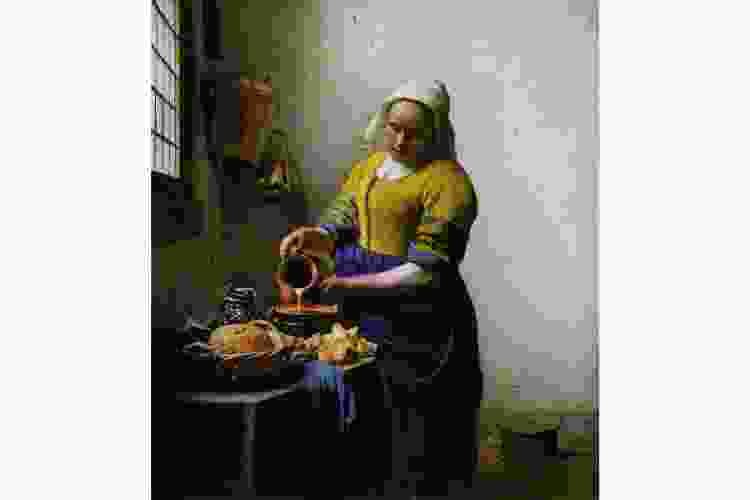
"The Milkmaid" is one of Vermeer’s most famous works of art because it contains all of the hallmarks of his style. He takes a normal subject like a young milkmaid and suffuses the image with light, allowing the viewers to see her from a new perspective and in a new way. Female subjects like milkmaids and lacemakers were not uncommon during the Dutch Golden Age, but Vermeer uses his skill as a painter to draw your eye to the importance of this young woman’s work.
3. Young Woman With a Pitcher (1662–64)

This painting, which resides at the Metropolitan Museum of Art in New York, wasn’t officially declared to be one of the Vermeer paintings until the 19th century. Painted early in his career, ‘Young Woman With a Pitcher’ is now seen as a turning point where Vermeer began to incorporate the themes and elements of light that would come to characterize his style.
4. Girl Reading a Letter at an Open Window (1657–58)

"Girl Reading a Letter at an Open Window" is one of the Vermeer paintings that shows just how often he re-imagined his own artwork by painting over different elements. For many decades, the girl in this painting stood in front of her open window, reading a letter in front of a blank wall. With x-ray developments, it was uncovered that Vermeer had originally included a portrait of cupid on the wall behind her, giving insight that this letter is actually a love letter.
5. The Art of Painting (1666–68)
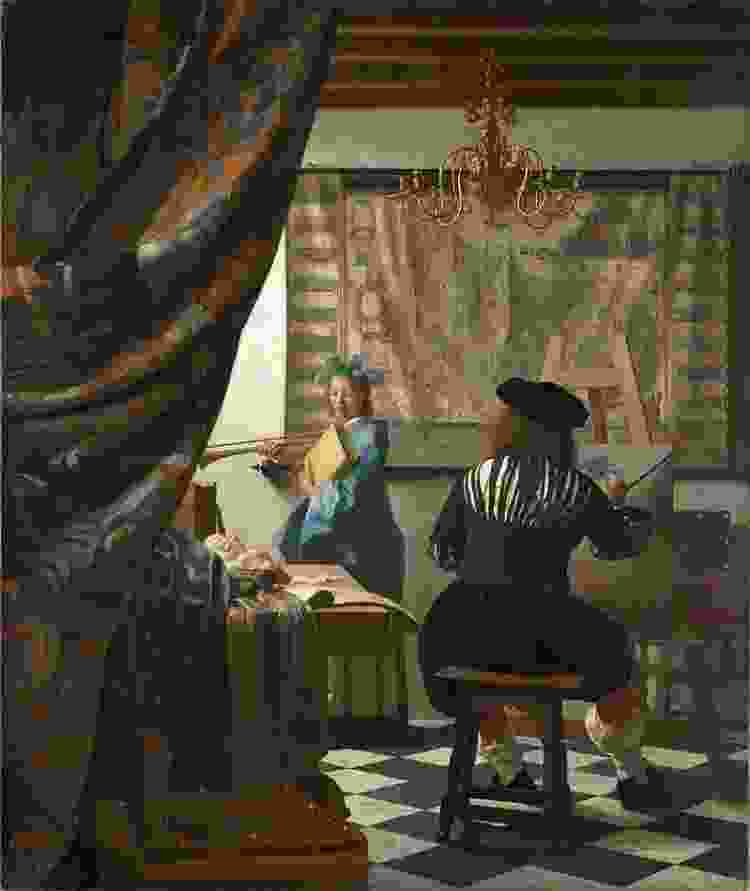
This is one of the Vermeer paintings you need to look deeper into. It seems, on the surface, to be just another scene of life in Delft. Does this painting show an image of Vermeer himself at work? In fact, "The Art of Painting" is one of Vermeer’s most symbolic and allegorical works. This could be a self-portrait of the artist, mainly because of the number of classical and religious symbols embedded into the painting. Instead, this painting is best said to show Vermeer’s view of art and the complicated relationship between the painted world and the real world.
6. The Love Letter (1669–70)

In many of the most famous Vermeer paintings, the subjects are alone in the frame, but in ‘The Love Letter,’ it's clear that a maid has just delivered a letter to the young woman seated in the center of the painting. The picture is framed through a doorway, so the viewer feels almost like they are eavesdropping or looking in on a private moment.
7. Woman in Blue Reading a Letter (1662–64)

Vermeer’s scenes of daily life are often soothing, but just like the life of this painter, there is always an element of the unknown lurking. In this painting, a young woman wearing a bright blue jacket is reading a letter. While we may never know the truth about what letter inspired this painting, Vermeer’s work allows the viewers’ imaginations to run wild and imagine different scenarios based on their own interpretation of the art. These types of Vermeer paintings call for self-reflection and deeper consideration.
8. Allegory of the Catholic Faith (1670–74)

Vermeer’s themes and expression might have changed over the course of his career, but he never fully got away from including religious elements in his work. This painting is an allegory, which means that each element in the painting stands for something else. Vermeer based many of the symbolic elements in this painting from earlier Italian ideas of iconography such as from Renaissance paintings like the famous Raphael paintings, so it's possible to examine each element of this artwork for several layers of meaning.
9. The Geographer (1669)
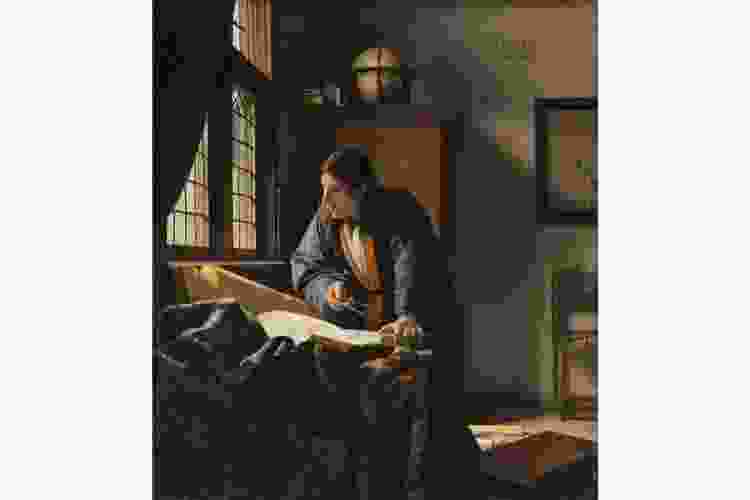
During the Dutch Golden Age, art, trade and science were all flourishing in the Netherlands. ‘The Geographer’ is one of the Vermeer paintings that pays homage to that by showing a man looking out of his window while leaning over a map. More than any of his other paintings, this one, paired with ‘The Astronomer’ show what was happening culturally and scientifically during Vermeer’s lifetime in Delft.
10. Woman Holding a Balance (1662–64)

"Woman Holding a Balance" is another of the Vermeer paintings that combines his later talent for light and perspective with his earlier religious works. In this painting, a woman is seen weighing small objects using a balance. She is calm and poised, and behind her on the wall is an image of the last judgment. In the Christian faith, this is the moment when humans’ souls are judged. The action of being weighed in a balance is represented in both places in this beautiful work by Vermeer.
11. View of Delft (1660–61)

On first glance, this may seem like one of the more dull Vermeer paintings and not as iconic as "Girl with a Pearl Earring," but this is one of Vermeer’s masterpieces, along with “Little Street.” Located in Mauritshuis, this incredible work of realism shows a view of the city Vermeer knew best, Delft. The painting demonstrates his talent for showing texture, light and perspective, and this painting has had a large cultural impact. The novelist Marcel Proust made this painting a key aspect in his novel In Search of Lost Time, and Proust himself believed this to be one of the most beautiful Vermeer paintings, in fact, the most beautiful ever painted.
12. A Young Woman Standing at a Virginal (1670–72)

Though many Vermeer paintings contain images of simple, indoor scenes, there is always another element to be noticed hiding beneath the surface. In this Vermeer painting, we see a woman who is playing a virginal or harpsichord, which often signifies romance. Another nod to romance in the painting is the portrait of Cupid Vermeer recreated behind her. Is she waiting for her lover? We may never know the backstory of this romance-tinged image.
13. The Lacemaker (1666–68)

Another painting that demonstrates some peculiarities of perspective is "The Lacemaker," one of the smallest Vermeer paintings. It's only about nine inches high, making it smaller than an average sheet of printer paper. The study of a young girl making lace contains an extraordinary amount of detail, but the slightly out-of-focus nature of the painting has caused some art critics to wonder whether Vermeer was using a camera obscura to recreate this image before painting it.
14. A Maid Asleep (1656–57)

This painting of a young woman sleeping at a table is calm and peaceful, but it has elements of mystery to it. X-ray technology has shown that several different areas of this painting were covered over by the artist. One such painted-over part is the figure of a man in the doorway. Some believe that this shadowy figure could have a more sinister interpretation, while others maintain that the figure in the doorway was holding a paintbrush. Their theory is that the man could be a self-portrait of Johannes Vermeer.
15. The Astronomer (1668)

Here is another one of the more controversial Vermeer paintings. Some art critics believe this painting was originally intended to be in a pair with ‘The Geographer.’ It shows a man at a desk with his hand outstretched over a globe. Vermeer pays tribute to his earlier religious paintings in this work by showing a painting on the wall behind the astronomer that depicts Baby Moses.
16. Woman With a Pearl Necklace (1662–64)

In this work of art, like in many Vermeer paintings, there is a woman standing in front of a window. Yet, in this one, there is a small mirror, and she is holding up a pearl necklace to the light. This is one of the Vermeer paintings that show all of his key characteristics as a painter, from the calm, stylized interior of the scene to the play of light on the wall, the girl's clothes and the pearl necklace.
17. Officer With a Laughing Girl (1657–58)
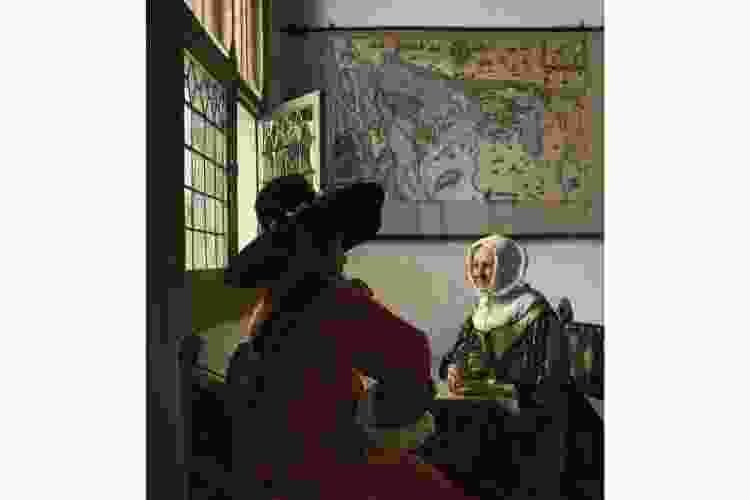
This is one of the more intriguing Vermeer paintings, as it shows an officer with his back to the viewer. Sitting across the table from him is a girl, who might have been modeled on Vermeer’s wife. This is one of the paintings that make art critics wonder about Vermeer’s use of early camera technologies, like the camera obscura, as there is a distinct scale difference between the two figures in the painting.
We hope this brief introduction to the life and paintings of Johannes Vermeer has inspired you to create your own works of art.
For even more painting ideas, check out other experiences happening on Classpop!

